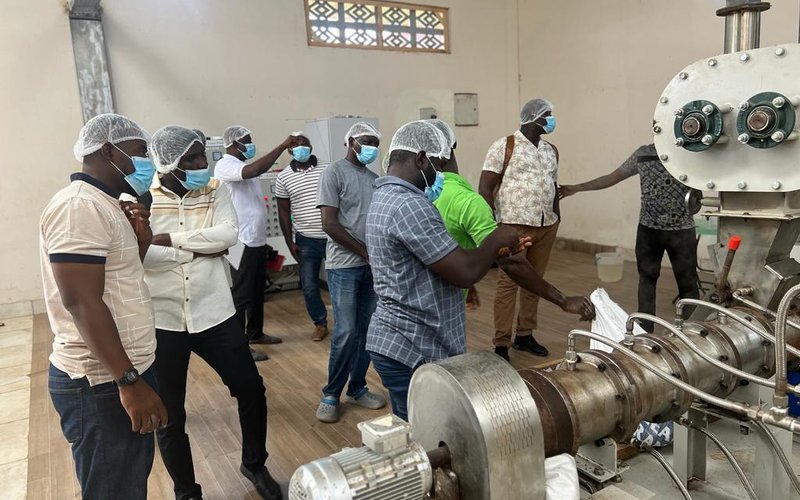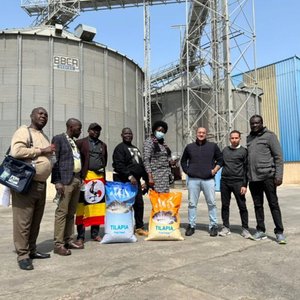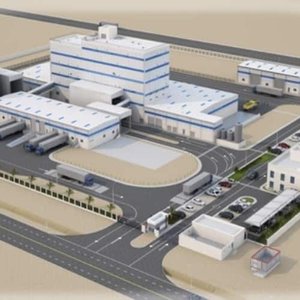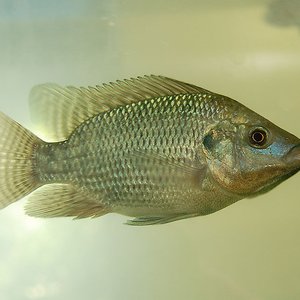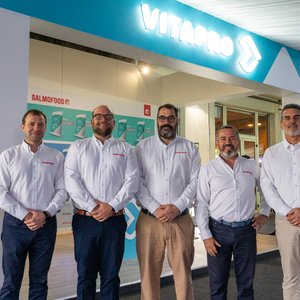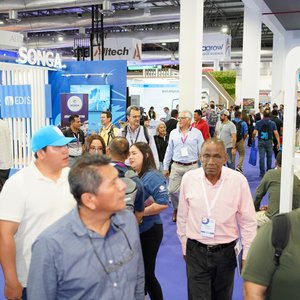Due to the importance of farmed fish to their economies, most African countries are pursuing national aquaculture strategies aimed, among other things, at cutting high fish import bills and raising protein consumption among increasing populations. However, their efforts have been hindered by the high cost of commercial fish feed. This is due to the high competing demands for corn by humans, the manufacturing industry and livestock farming, and the high cost of importing soy meal. Although quite a few alternative ingredients have been found to be viable, the presence of anti-nutritional factors precluded commercial production. Recent developments in Ghana indicate that the production of commercial fish feed based on alternative ingredients will begin shortly.
The quest for affordable feeds
Ghanaian researchers have been seeking alternative ingredients to corn and soy meal for some two decades, although the initial focus was on the poultry industry. However, with the introduction of the National Aquaculture Development Plan, which saw aquaculture production increase from 10,000 metric tonnes in 2011 to 55,000 metric tonnes in 2016, research on alternative fish feed ingredients also gained prominence.
Cocoa pod husk, coconut cake, palm kernel cake and groundnut cake, among several others, were found to be viable substitutes for the two major ingredients. However, due to the presence of anti-nutritional factors, their inclusion was recommended at only limited levels. Fermentation and heat treatment were among the recommended methods for neutralizing the anti-nutritional factors but further work seems to have been discouraged by the availability of “moderate-priced”, locally produced Raanan Feed and several foreign brands.
Quite a number of fish farmers try to cut costs by compounding their own feed on-farm, combining ingredients like cocoa pod husk, palm kernel cake, cotton seed cake, wheat bran and maize bran. Ben Mensah, a small farmer, said that “apart from the anti-nutritional factor challenge, most small farmers do not have extruders or processors, and we lack the bio-security facilities for efficient feed production. We are more than excited that help is on the way.”
Apart from being the main human food source for most Africans, corn is also a major raw material in the brewery and pharmaceutical industries, and the main feed ingredient in poultry, pig and fish feed. As if those weren’t enough, speculators are trading in corn across West Africa, especially between Ghana, Nigeria and Niger/Mali, and this fuels scarcity. An indicator of the volatility of corn prices is the 100.9% surge in prices in Nigeria from 227,500 naira per tonne to 480,000 naira per tonne in June of this year.
In February 2021, the Catfish Farmers Association of Nigeria (CAFAN), the largest association of fish farmers, mobilized funds from its members and started its own Cafan/Flourish Fish Feed, as an antidote to the high prices of local and imported brands. Its numerous members patronized it initially, but since corn and soy meal were the main ingredients used, the prices were not much different from other brands, and interest waned.
Governments in Ghana, Nigeria and other African countries have often imported corn to help meet the requirements of livestock farmers. In September, the Nigerian press called for a massive importation of corn to stave off a looming crisis in the livestock sector due to the shortage of corn. In Kenya, President Ruto announced on September 29 that the government would import duty-free yellow corn and lower the cost of animal feed to make things easier for livestock farmers.
According to Index Mundi, Ghana imported 100,000 metric tonnes of maize last year, and is projected to import the same amount this year. It is also projected to import soy meal, mostly from the US, to plug its consumption gap of 200,000 metric tonnes.
A new local initiative
Last year, the Ghana Aquaculture Association embarked on a search for solutions, following increased complaints from fish farmers that they have had to slash or suspend production due to increasing feed costs. A major step forward was taken recently when a workshop on the Commercial Development of Fish Feed was jointly convened by the association in collaboration with the Fisheries Commission and the Norwegian Agency for Development. Presentations were given by key presenters from the universities, research institutions and fish farmers. The workshop was hosted by R and D Fish Farms, one of Ghana’s biggest fish farmers, and the presentations were followed by tests of alternative feeds at the farm’s modern processing facility.
The workshop was followed by a Scientific Committee meeting, at which it was decided to run trials with aquafeeds including alternative ingredients such as wheat bran, rice bran, corn bran, black soldier fly larvae, duckweed, azolla and leucaena. The initial trials will involve grow-out feeds that will be tested at three hapa, earthen pond and tarpaulin pond locations. In the long term, efforts will be made to deal with the anti-nutritional factors in palm kernel cake, cocoa pod husk and others. Trials will be followed by the selection of formulas for processing.
Kofitsyo Cudjoe, a senior adviser at the Norwegian Veterinary Institute’s Aquatic Animal Health and Welfare Department, who represented NORAD, said that “this is an important moment in the development of aquaculture in Ghana. Aquaculture is expected to play a major role in plugging the 60% gap in fish supply, but this will be difficult at the current feed price levels. I am confident that with the kind of commitment shown, we will see a major change soon.”
David Adade, CEO of Windmill Farms, who was one of the presenters, said “I was happy to be called to contribute to the development of alternative commercial feed. Soon after starting tilapia and catfish production, I realized that commercial feed prices were quite high when there were quite a number of viable alternatives available. Mainly, I have used ingredients like duckweed, water lettuce, and black soldier fly larvae, which I produce myself, and very small amounts of commercial feed. The alternative ingredients are not only viable, I produce catfish of over 1.2 kilos in less than the ‘usual’ six months, using what I call the two-tier cage system.”
David Pessey, a livestock nutritionist, said, “we will soon see profitable fish farming in Ghana, and we will share our experience with other African countries. Now that we have begun the alternative feed journey, I expect that we will soon develop solutions to the anti-nutritional factors that have been in abeyance for so long. We produce vast amounts of cocoa pod husk and palm kernel cake, for example, which could help release massive amounts of cheap fish feed to fish farmers.”
Danny Van Mullem, CEO of Lambert Seghers, said that “Ghana has great potential to produce cheap feed for the local and African aquaculture market. We are talking to the government about developing a single-cell protein (SCP) facility, for which the tropical climate offers an advantage. We hope to play a significant role in this field.”


